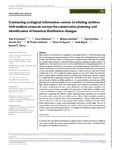Contrasting ecological information content in whaling archives with modern cetacean surveys for conservation planning and identification of historical distribution changes
| dc.contributor.author | Letessier, TB | |
| dc.contributor.author | Mannocci, L | |
| dc.contributor.author | Goodwin, B | |
| dc.contributor.author | Embling, Clare | |
| dc.contributor.author | de Vos, A | |
| dc.contributor.author | Anderson, RC | |
| dc.contributor.author | Ingram, Simon | |
| dc.contributor.author | Rogan, A | |
| dc.contributor.author | Turvey, ST | |
| dc.date.accessioned | 2023-02-28T17:38:21Z | |
| dc.date.issued | 2023-02-09 | |
| dc.identifier.issn | 1523-1739 | |
| dc.identifier.issn | 1523-1739 | |
| dc.identifier.other | e14043 | |
| dc.identifier.uri | http://hdl.handle.net/10026.1/20521 | |
| dc.description.abstract |
<jats:title>Abstract</jats:title><jats:p>Many species are restricted to a marginal or suboptimal fraction of their historical range due to anthropogenic impacts, making it hard to interpret their ecological preferences from modern‐day data alone. However, inferring past ecological states is limited by the availability of robust data and biases in historical archives, posing a challenge for policy makers . To highlight how historical records can be used to understand the ecological requirements of threatened species and inform conservation, we investigated sperm whale (<jats:italic>Physeter macrocephalus</jats:italic>) distribution in the Western Indian Ocean. We assessed differences in information content and habitat suitability predictions based on whale occurrence data from Yankee whaling logs (1792–1912) and from modern cetacean surveys (1995–2020). We built maximum entropy habitat suitability models containing static (bathymetry‐derived) variables to compare models comprising historical‐only and modern‐only data. Using both historical and modern habitat suitability predictions we assessed marine protected area (MPA) placement by contrasting suitability in‐ and outside MPAs. The historical model predicted high habitat suitability in shelf and coastal regions near continents and islands, whereas the modern model predicted a less coastal distribution with high habitat suitability more restricted to areas of steep topography. The proportion of high habitat suitability inside versus outside MPAs was higher when applying the historical predictions than the modern predictions, suggesting that different marine spatial planning optimums can be reached from either data sources. Moreover, differences in relative habitat suitability predictions between eras were consistent with the historical depletion of sperm whales from coastal regions, which were easily accessed and targeted by whalers, resulting in a modern distribution limited more to steep continental margins and remote oceanic ridges. The use of historical data can provide important new insights and, through cautious interpretation, inform conservation planning and policy, for example, by identifying refugee species and regions of anticipated population recovery.</jats:p> | |
| dc.format.extent | e14043- | |
| dc.format.medium | Print-Electronic | |
| dc.language | en | |
| dc.language.iso | eng | |
| dc.publisher | Wiley | |
| dc.subject | baselines | |
| dc.subject | historical ecology | |
| dc.subject | niche | |
| dc.subject | range shift | |
| dc.subject | refugee species | |
| dc.subject | residual | |
| dc.subject | sperm whale | |
| dc.title | Contrasting ecological information content in whaling archives with modern cetacean surveys for conservation planning and identification of historical distribution changes | |
| dc.type | journal-article | |
| dc.type | Journal Article | |
| dc.type | Research Support, Non-U.S. Gov't | |
| plymouth.author-url | https://www.webofscience.com/api/gateway?GWVersion=2&SrcApp=PARTNER_APP&SrcAuth=LinksAMR&KeyUT=WOS:000934939800001&DestLinkType=FullRecord&DestApp=ALL_WOS&UsrCustomerID=11bb513d99f797142bcfeffcc58ea008 | |
| plymouth.issue | 3 | |
| plymouth.volume | 37 | |
| plymouth.publication-status | Published | |
| plymouth.journal | Conservation Biology | |
| dc.identifier.doi | 10.1111/cobi.14043 | |
| plymouth.organisational-group | /Plymouth | |
| plymouth.organisational-group | /Plymouth/Faculty of Science and Engineering | |
| plymouth.organisational-group | /Plymouth/Faculty of Science and Engineering/School of Biological and Marine Sciences | |
| plymouth.organisational-group | /Plymouth/REF 2021 Researchers by UoA | |
| plymouth.organisational-group | /Plymouth/REF 2021 Researchers by UoA/UoA07 Earth Systems and Environmental Sciences | |
| plymouth.organisational-group | /Plymouth/Research Groups | |
| plymouth.organisational-group | /Plymouth/Research Groups/Marine Institute | |
| plymouth.organisational-group | /Plymouth/Users by role | |
| plymouth.organisational-group | /Plymouth/Users by role/Academics | |
| dc.publisher.place | United States | |
| dcterms.dateAccepted | 2022-11-21 | |
| dc.rights.embargodate | 2023-3-4 | |
| dc.identifier.eissn | 1523-1739 | |
| dc.rights.embargoperiod | Not known | |
| rioxxterms.versionofrecord | 10.1111/cobi.14043 | |
| rioxxterms.licenseref.uri | http://www.rioxx.net/licenses/all-rights-reserved | |
| rioxxterms.licenseref.startdate | 2023-02-09 | |
| rioxxterms.type | Journal Article/Review |


